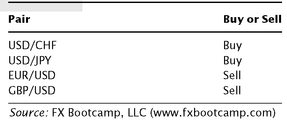WHAT’S YOUR USD BIAS?
The only thing you need to do is determine your bias (if the U.S. dollar is likely to strengthen or weaken, in your opinion), then apply this bias to the various major currency pairs.
Notice what side of the equation the USD is in the currency pair. When you buy a currency pair, you are buying the first currency and selling the other.
For example, if your bias is for the U.S. dollar to strengthen, then you would want to buy USD. Table 7.2 is a list of the kind of trade you would enter in each of the four major currency pairs.
TABLE 7.2 Trading the Four Major Currency Pairs

In all cases, you are long the USD and short the other currency in the pair. One bias, four trades!
This is generally true, but each currency pair will react differently to the USD. That’s because each local currency pair has its own strengths and weaknesses—its own value. For example, if the EUR is also strengthening it would move less with the USD strengthening than the JPY if the yen was weakening.
Here’s a trade trick you can try. Let’s say you can only afford to place one mini lot trade and you have a bearish bias for the USD. You can consider going long the GBP/USD or EUR/USD—but which currency pair do you trade? Take a look at the EUR/GBP. Which is stronger, the EUR or the GBP? Trade the stronger currency on the majors using your bias for the USD. If EUR/GBP is down, go ...
Get The FX Bootcamp Guide to Strategic and Tactical Forex Trading now with the O’Reilly learning platform.
O’Reilly members experience books, live events, courses curated by job role, and more from O’Reilly and nearly 200 top publishers.

